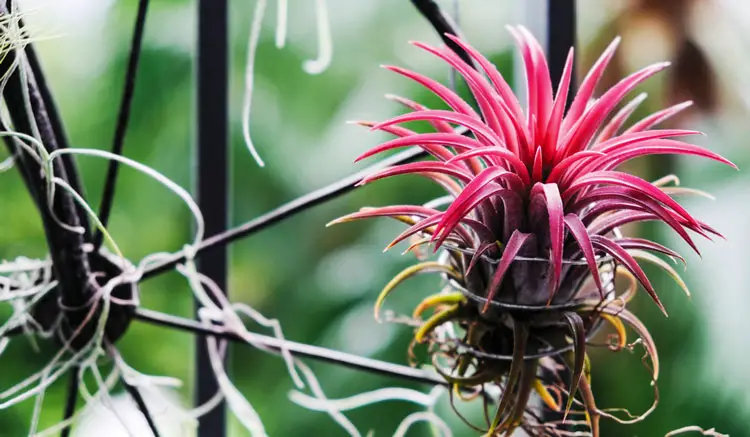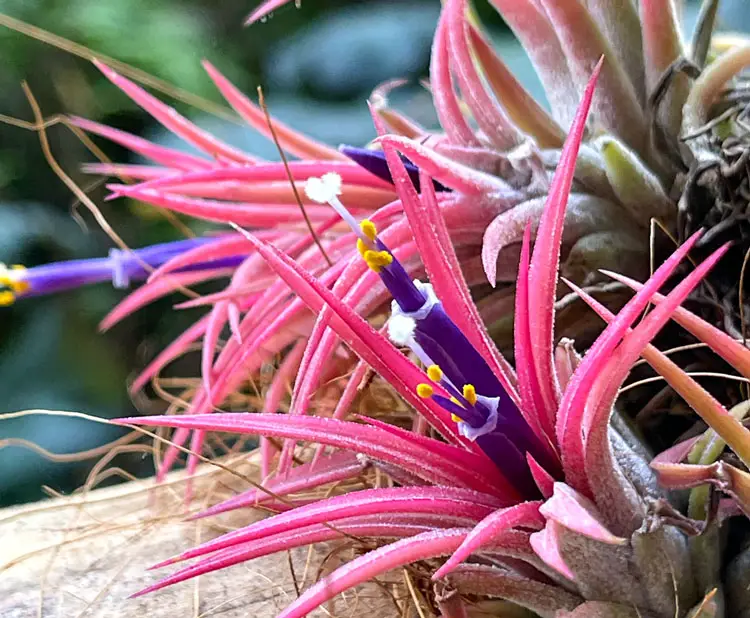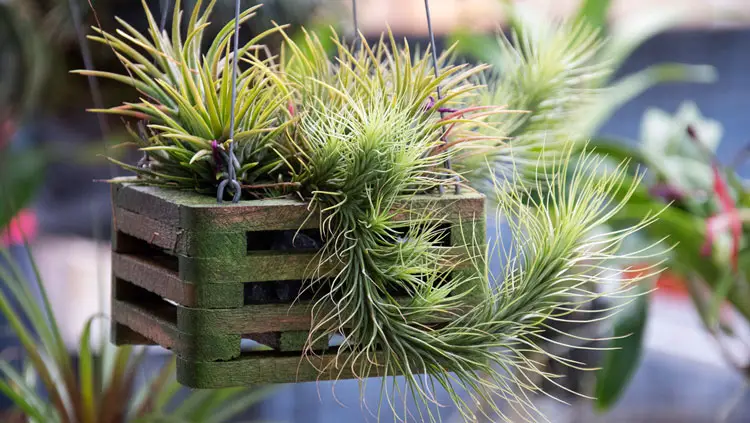How Long Do Air Plants Live? What To Do During Your Plants Final Stage

This post follows our research editorial guidelines.

What’s not to love about the spiky, almost alien air plant (Tilladsia)? They’re easy to care for, virtually unkillable with an enduring charm. But even the unsinkable ship can go down, and air plants are no different.
So, how do you guard against losing these fuzzy looking aliens?
Most air plants have a life span of four to five years. They finish their lives with a final flower before withering away. At this point new air plant pups will appear to start the next generation of air plants.

Table of Contents
How To Tell If an Air Plant Is Dying
Air plants aren’t a communicative plant. If you want to cut problems off before they really get established, you have to keep your eyes peeled. Look out for:
- crisp, brown leaf tips
- shriveled leaves
- soft, soggy patches
- foul smells, especially musty or eggy ones
- flowers
“Tillandsia are the houseplants of the moment in the gardening scene! Care is not difficult if you understand how they grow in their natural environment.”
Sandy Vanno, Cornell Cooperative Extension Master Gardener.
Why Is My Air Plant Dying?
Air plants largely come in two types – mesic and xeric. This describes where they grow naturally, and the conditions they need to thrive.
Mesic air plants are rain-forest plants. They grow under dark canopies, and enjoy humid air and regular watering. Their leaves are deeper greens, slightly cupped and smooth to allow water to flow freely away. They also look more like tiny bromeliads than their xeric cousins.
Xeric air plants on the other hand come from arid regions, with less rainfall and more punishing temperatures. They are fuzzy-leafed, to trap the dew and to prevent dehydration. Their fluffy leaves also protect them from sharp changes in temperature.
Both types of air plant have similar needs, but there’s some crucial differences. A mesic air plant needs higher humidity and more regular watering, and a xeric needs more light. If you’re hitting all the right targets for care and still have problems, it may be due to the differences in their needs.
Incorrect Light
Air plants need lots of bright indirect light a day to thrive. If you’re growing a xeric air plant they’ll do best with a little more, as well as a bit of time in an early morning sunbeam.
If your air plant is losing its color uniformly and has an overall shabby appearance, it’s likely to be a light issue.
Too Cold
Air plants aren’t too fussy about the temperatures they grow in. They can tolerate small bursts of astonishing cold, especially the fuzzy xeric types. But for good growth and the best lifespan, they need to be kept warm. Too cold and their already sluggish metabolisms slow to a crawl, and they become more vulnerable to rot and attacks from pests.
Too Little Water
Everyone gets busy sometimes, and it’s easy to forget to water your air plant. After all, Tillandsias are known to be very forgiving to the tardy gardener.
Watch out for wrinkled, dry looking leaves, puckered bases and browning or crisp leaf tips. This all signals that your air plant needs a good deep drink. If ignored, the plant will start shedding leaves in papery waves.
If you have a mesic air plant, watch the humidity in your growing environment, too. These guys hail from rainforests, and need a reliable amount of moisture in the air. While I wouldn’t suggest you break out the humidifier for a plant as big as a fun-size Snickers, low humidity will mean you’ll need to water more often to keep them in good shape.

Heavily Treated Tap Water
I sometimes marvel at how lucky we are to live in an age of abundant, safe drinking water. But there’s a lot of work that goes into making that water safe – and a lot of chemical treatments, too.
City tap water contains chlorine to destroy dangerous pathogens, and in some places fluorine too in order to protect teeth and bones. All of this can signal disaster to chemically sensitive plants like the Tillandsias.
Watch out for singed edges on the leaves, as if they’ve been burned. You’ll also notice they seem off-color and feeble no matter what you do.
Dust
The irony here is that in the wild, air plants love to get a little dusty. They take nutrition from whatever lands on their leaves, with the aid of special structures called trichomes.
But in your average home, the dust is not always wholesome. Polyester fibers from clothing, pet hair, and grease from kitchen cooking can all clog the air plant’s leaves. They stop the plant from breathing, leading to a slow, painful demise.
Pests and Disease
Air plants are in general pest and disease resistant. This makes it all the more shocking when noxious insects or fungal outbreaks appear as if from nowhere!
The big villains to watch for with air plants are mealybugs and rot. Mealybugs are easy to spot – they’re grainy little fluffballs, a whole group of sap loving insects that’ll literally suck the life right from your poor air plant.
Rot on the other hand is more insidious – it attacks damp areas of the plant, like the base of leaves after watering. Caused by fungi, rot causes sponginess, foul smells of decomposition, and leaf drop.
How To Revive a Dying Air Plant
Step 1: Deeply Hydrate
First step for any sickly air plant is a good deep drink.
The best way to water an ailing air plant is to let it soak overnight in clean, lukewarm water. Rainwater is best for this job, but distilled or filtered water is fine too
Fill a large bowl and immerse the air plant. Give it a good swirl to dislodge dust or any pests clinging to the surface, and let it soak overnight.
The Tillandsia will use those miraculous leaves to suck the water right up. Soaking for a good eight to twelve hours rehydrates very thoroughly, and will also drown any nasty insects hiding in those lovely leaves.
In future you’d generally only soak it for a half an hour one or twice a week. Some folks also swear by rinsing their Tillandsias under a tap instead, to take nasties away down the drain.

Step 2: Check for Pests and Disease
Once you’ve given it a good drink, check the water left in the bowl. Floating insects are a sign you might have an infestation to deal with. Take a good look at the Tillandsia’s leaves too for signs of damage, or the pests themselves.
While mealybugs are the biggest nuisance to air plants, other bugs like spider mites, thrips or aphids aren’t fussy and will take a nibble of your air plant given half a chance.
I don’t waste time with pest infestations. While an overnight soak is likely to kill everything on your air plant, check any other plants in your collection and treat the lot with a neem oil spray. Air plants don’t usually attract pests, so if yours has them it’s likely the other plants in your home do, too.
The other thing to look for is rot. Inspect the base of your leaves for soft, squashy areas or discoloration. Any soft or soggy leaves should be immediately removed with clean shears or scissors. I’d also suggest you dust any affected areas thoroughly with powdered cinnamon, which serves as a low impact but very effective anti-fungal and antibacterial agent.
Step 3: Remove Dead or Dying Leaves
In addition to leaves suffering from rot, any old and dried out leaves should be removed. Truly dead leaves tend to flake away all on their own, but you can also delicately trim them away with clean scissors. Removing these old leaves prevents rots and prompts the Tillandsia to sprout some new foliage.
Step 4: Allow To Dry Completely
Once all the hard parts are done, place your air plant on a towel upside down and allow to dry thoroughly. I like to give mine a good shake too, just to be doubly sure.
Water trapped at the base of leaves often leads to fungal problems and rotten leaves, so always make sure your air plant is truly dry before you put it back in its spot after watering.
How To Improve The Life Expectancy Of An Air Plant
Ensure Good Light
For mesic air plants, aim to have around 6-8 hours of bright, indirect light. Try and keep them away from direct sunlight. They really don’t appreciate it and it’ll dry them out faster. Watch out for stray sunbeams as the seasons progress, too – a sunny corner in spring may become intolerably hot and bright by high summer.
For xeric air plants, aim for over 8 hours if you can, with an hour or so direct light early in the morning. A south-eastern facing window is an ideal spot to let them bask.
Fertilize
Tillandsias are not heavy feeders. But if you want to really get the most out of them, it’s a good idea to fertilize them every now and then.
I like to add a little diluted specialist bromeliad fertilizer to their bath water, once a month during the summer and spring. One quarter strength per the label is generally enough. This will give the air plant a nice boost to its nutrition without the risk of overwhelming their delicate systems.
Provide Good Humidity
Tillandsias like to be kept at between 65 and 85℉ (18 to 30°C) during the daytime, and will tolerate dips in temperature down to 50℉ overnight. (10°C) Try and keep them clear of drafts, like HVAC vents or fans. Consistency is key.
Check your humidity, too. An electronic hygrometer is an excellent tool for any avid indoor gardener. Be aware humidity tends to drop over winter as the central heating kicks into gear, so you’ll either need to water more often, or move the air plant to a humid space like a bathroom.
Make Peace With The Air Plant’s Life Cycle.
Sadly, all things move towards their end, and Tillandsias have a poignant way to signal that they’ve reached the natural end of their lives. Air plants will only ever flower once. The whole flowering process can take months, but once it’s over the plant will wither and die.
I write more about that here, but the long and the short of it is that there’s nothing you can do to stop it. Cell death starts before the bud even emerges, so just sit back and enjoy the air plant’s swan song.
Slow and steady wins the race for Tillandsias, taking their time reaching maturity, elegant in their own weird way. It’s always a pleasure to let them to take us along for the ride. If your lucky you may just be left with a few air plant pups.

Before you go!
Types of Basil to Grow in Your Garden
How Long Do Peace Lilies Live?
7 Common Peace Lily Pests and Diseases + How To Prevent Them
5 Signs a Money Tree Needs Watering